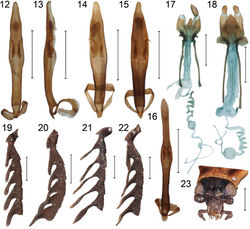Cautires
| Notice: | This page is derived from the original publication listed below, whose author(s) should always be credited. Further contributors may edit and improve the content of this page and, consequently, need to be credited as well (see page history). Any assessment of factual correctness requires a careful review of the original article as well as of subsequent contributions.
If you are uncertain whether your planned contribution is correct or not, we suggest that you use the associated discussion page instead of editing the page directly. This page should be cited as follows (rationale):
Citation formats to copy and paste
BibTeX: @article{Bocak2012ZooKeys241, RIS/ Endnote: TY - JOUR Wikipedia/ Citizendium: <ref name="Bocak2012ZooKeys241">{{Citation See also the citation download page at the journal. |
Ordo: Coleoptera
Familia: Lycidae
Name
Cautires Waterhouse, 1879 – Wikispecies link – Pensoft Profile
Type species
Lycus (gen. 22) excellens Waterhouse, 1878; Bourgeois 1891[1]: 345, by subsequent designation.
Differential diagnosis of the Cautires obsoletus species group
Cautires belongs to the tribe Metriorrhynchini, which is easily recognizable by well-developed pronotal and elytral costae, a circular phallobase and unpaired gland in the vagina (Bocak 2002[2]).All species classified in the Cautires obsoletus group share principal diagnostic characters with other Cautires: a medium sized, flattened, feebly sclerotized body, flabellate antennae in males which are serrate in females, four primary and five secondary longitudinal costae in the elytra, and a lanceolate phallus with membranous internal sac bearing two sickle-shaped thorns at its base (Figs 1–23). The species groupis defined by the presence of a single median areola in the pronotum and it differs from the Cautires pauper species group in the obtuse frontal angles resulting in the triangular shape of the pronotum, and a slender phallus (Figs 7–16). The morphology of Cautires was described and illustrated in detail by Dudkova and Bocak (2010)[3].
Distribution and biology
The low dispersal propensity of metriorrhynchine net-winged beetles results in small ranges and effectiveness of barriers, which are crossed easily by other beetles (Kubecek et al. 2011[4]). Adults of net-winged beetles usually remain under the canopy of the tropical rain forest and do not fly in open habitat (Bocak 2002[2]). Extensive studies of South East Asian Cautires and other Metriorrhynchini revealed that each species is typically restricted to a single island, and that these beetles very seldom have extensive ranges (e.g. Dudkova and Bocak 2010[3], Weiszenstein and Bocak 2011[5]). Although Kleine (1933)[6] recorded several species of Cautires from two or more Great Sunda islands, the study of principal collections and extensive collecting activity in Sumatra and Borneo revealed that all Javanese species treated here are endemic to Java and do not occur in the other Great Sunda islands. So, for example, due to high similarity, Cautires apicalis described from Java has been for long time kept in synonymy of Cautires corporaali from Northern Sumatra and is reinstated as a valid species.
The second potential reason for the high level of endemism in net-winged beetles is the role of aposematic coloration. The majority of Metriorrhynchini in the Oriental Region are aposematically colored and the Javanese Cautires species are no exception (Figs 1–6). The similar orange and black pattern is known also from higher mountain regions of Sumatra, e.g. Gunung Kerinci, Gunung Merapi and volcanoes in the vicinity of Brastagi. These aposematic patterns are limited to higher mountain habitats and the lower areas are inhabited by differently colored species. The role of color patterns as a factor limiting dispersal was discussed by Bocak and Yagi (2010)[7].
Key to the Cautires obsoletus species group of Java
'Taxon Treatment
- Bocak, L; 2012: A revision of the Cautires obsoletus species group from Java (Coleoptera, Lycidae) ZooKeys, 241: 55-66. doi
Other References
- ↑ Bourgeois J (1891) Études sur la distribution géographic des Malacodermes. I. Lycides. Annales de la Societé entomologique de France 60: 337-364.
- ↑ 2.0 2.1 Bocak L (2002) Generic revision and phylogenetic analysis of the Metriorrhynchinae (Coleoptera: Lycidae). European Journal of Entomology 99: 315-351.
- ↑ 3.0 3.1 Dudkova P, Bocak L (2010) A review of the Cautires obsoletus species group from Indo–Burma (Coleoptera: Lycidae). Zootaxa 2527: 28-48.
- ↑ Kubecek V, Dvorak M, Bocak L (2011) The phylogenetic structure of Metriorrhynchini fauna of Sulawesi, (Coleoptera: Lycidae) with description of a new genus. Zoological Studies 50: 645-656.
- ↑ Weiszenstein M, Bocak L (2011) A review of the genus Metanoeus from the Philippines (Coleoptera: Lycidae). Raffles Bulletin of Zoology 59: 163-170.
- ↑ Kleine R (1933) Coleopterorum Catalogus auspiciis et auxilio W. Junk editus a S. Schenkling. Pars 128: Lycidae. W. Junk, Berlin, 145 pp.
- ↑ Bocak L, Yagi T (2010) Evolution of mimicry patterns in Metriorrhynchus (Coleoptera: Lycidae): the history of dispersal and speciation in South East Asia. Evolution 64: 39-52. doi: 10.1111/j.1558-5646.2009.00812.x
Images
|

